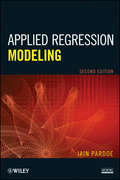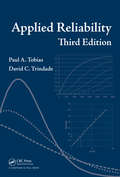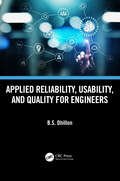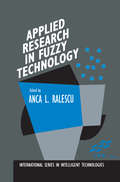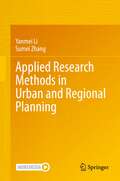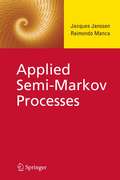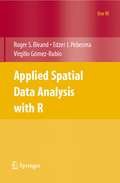- Table View
- List View
Applied Regression Modeling: A Business Approach
by Iain PardoePraise for the First Edition "The attention to detail is impressive. The book is very well written and the author is extremely careful with his descriptions . . . the examples are wonderful." —The American Statistician Fully revised to reflect the latest methodologies and emerging applications, Applied Regression Modeling, Second Edition continues to highlight the benefits of statistical methods, specifically regression analysis and modeling, for understanding, analyzing, and interpreting multivariate data in business, science, and social science applications. The author utilizes a bounty of real-life examples, case studies, illustrations, and graphics to introduce readers to the world of regression analysis using various software packages, including R, SPSS, Minitab, SAS, JMP, and S-PLUS. In a clear and careful writing style, the book introduces modeling extensions that illustrate more advanced regression techniques, including logistic regression, Poisson regression, discrete choice models, multilevel models, and Bayesian modeling. In addition, the Second Edition features clarification and expansion of challenging topics, such as: Transformations, indicator variables, and interaction Testing model assumptions Nonconstant variance Autocorrelation Variable selection methods Model building and graphical interpretation Throughout the book, datasets and examples have been updated and additional problems are included at the end of each chapter, allowing readers to test their comprehension of the presented material. In addition, a related website features the book's datasets, presentation slides, detailed statistical software instructions, and learning resources including additional problems and instructional videos. With an intuitive approach that is not heavy on mathematical detail, Applied Regression Modeling, Second Edition is an excellent book for courses on statistical regression analysis at the upper-undergraduate and graduate level. The book also serves as a valuable resource for professionals and researchers who utilize statistical methods for decision-making in their everyday work.
Applied Regression Modeling
by Iain PardoePraise for the First Edition "The attention to detail is impressive. The book is very well written and the author is extremely careful with his descriptions . . . the examples are wonderful." —The American Statistician Fully revised to reflect the latest methodologies and emerging applications, Applied Regression Modeling, Second Edition continues to highlight the benefits of statistical methods, specifically regression analysis and modeling, for understanding, analyzing, and interpreting multivariate data in business, science, and social science applications. The author utilizes a bounty of real-life examples, case studies, illustrations, and graphics to introduce readers to the world of regression analysis using various software packages, including R, SPSS, Minitab, SAS, JMP, and S-PLUS. In a clear and careful writing style, the book introduces modeling extensions that illustrate more advanced regression techniques, including logistic regression, Poisson regression, discrete choice models, multilevel models, and Bayesian modeling. In addition, the Second Edition features clarification and expansion of challenging topics, such as: Transformations, indicator variables, and interaction Testing model assumptions Nonconstant variance Autocorrelation Variable selection methods Model building and graphical interpretation Throughout the book, datasets and examples have been updated and additional problems are included at the end of each chapter, allowing readers to test their comprehension of the presented material. In addition, a related website features the book's datasets, presentation slides, detailed statistical software instructions, and learning resources including additional problems and instructional videos. With an intuitive approach that is not heavy on mathematical detail, Applied Regression Modeling, Second Edition is an excellent book for courses on statistical regression analysis at the upper-undergraduate and graduate level. The book also serves as a valuable resource for professionals and researchers who utilize statistical methods for decision-making in their everyday work.
Applied Regression Modeling
by Iain PardoeMaster the fundamentals of regression without learning calculus with this one-stop resource The newly and thoroughly revised 3rd Edition of Applied Regression Modeling delivers a concise but comprehensive treatment of the application of statistical regression analysis for those with little or no background in calculus. Accomplished instructor and author Dr. Iain Pardoe has reworked many of the more challenging topics, included learning outcomes and additional end-of-chapter exercises, and added coverage of several brand-new topics including multiple linear regression using matrices. The methods described in the text are clearly illustrated with multi-format datasets available on the book's supplementary website. In addition to a fulsome explanation of foundational regression techniques, the book introduces modeling extensions that illustrate advanced regression strategies, including model building, logistic regression, Poisson regression, discrete choice models, multilevel models, Bayesian modeling, and time series forecasting. Illustrations, graphs, and computer software output appear throughout the book to assist readers in understanding and retaining the more complex content. Applied Regression Modeling covers a wide variety of topics, like: Simple linear regression models, including the least squares criterion, how to evaluate model fit, and estimation/prediction Multiple linear regression, including testing regression parameters, checking model assumptions graphically, and testing model assumptions numerically Regression model building, including predictor and response variable transformations, qualitative predictors, and regression pitfalls Three fully described case studies, including one each on home prices, vehicle fuel efficiency, and pharmaceutical patches Perfect for students of any undergraduate statistics course in which regression analysis is a main focus, Applied Regression Modeling also belongs on the bookshelves of non-statistics graduate students, including MBAs, and for students of vocational, professional, and applied courses like data science and machine learning.
Applied Regression Modeling: A Business Approach
by Iain PardoeMaster the fundamentals of regression without learning calculus with this one-stop resource The newly and thoroughly revised 3rd Edition of Applied Regression Modeling delivers a concise but comprehensive treatment of the application of statistical regression analysis for those with little or no background in calculus. Accomplished instructor and author Dr. Iain Pardoe has reworked many of the more challenging topics, included learning outcomes and additional end-of-chapter exercises, and added coverage of several brand-new topics including multiple linear regression using matrices. The methods described in the text are clearly illustrated with multi-format datasets available on the book's supplementary website. In addition to a fulsome explanation of foundational regression techniques, the book introduces modeling extensions that illustrate advanced regression strategies, including model building, logistic regression, Poisson regression, discrete choice models, multilevel models, Bayesian modeling, and time series forecasting. Illustrations, graphs, and computer software output appear throughout the book to assist readers in understanding and retaining the more complex content. Applied Regression Modeling covers a wide variety of topics, like: Simple linear regression models, including the least squares criterion, how to evaluate model fit, and estimation/prediction Multiple linear regression, including testing regression parameters, checking model assumptions graphically, and testing model assumptions numerically Regression model building, including predictor and response variable transformations, qualitative predictors, and regression pitfalls Three fully described case studies, including one each on home prices, vehicle fuel efficiency, and pharmaceutical patches Perfect for students of any undergraduate statistics course in which regression analysis is a main focus, Applied Regression Modeling also belongs on the bookshelves of non-statistics graduate students, including MBAs, and for students of vocational, professional, and applied courses like data science and machine learning.
Applied Regularization Methods for the Social Sciences (Chapman & Hall/CRC Statistics in the Social and Behavioral Sciences)
by Holmes FinchResearchers in the social sciences are faced with complex data sets in which they have relatively small samples and many variables (high dimensional data). Unlike the various technical guides currently on the market, Applied Regularization Methods for the Social Sciences provides and overview of a variety of models alongside clear examples of hands-on application. Each chapter in this book covers a specific application of regularization techniques with a user-friendly technical description, followed by examples that provide a thorough demonstration of the methods in action. Key Features: Description of regularization methods in a user friendly and easy to read manner Inclusion of regularization-based approaches for a variety of statistical analyses commonly used in the social sciences, including both univariate and multivariate models Fully developed extended examples using multiple software packages, including R, SAS, and SPSS Website containing all datasets and software scripts used in the examples Inclusion of both frequentist and Bayesian regularization approaches Application exercises for each chapter that instructors could use in class, and independent researchers could use to practice what they have learned from the book
Applied Regularization Methods for the Social Sciences (Chapman & Hall/CRC Statistics in the Social and Behavioral Sciences)
by Holmes FinchResearchers in the social sciences are faced with complex data sets in which they have relatively small samples and many variables (high dimensional data). Unlike the various technical guides currently on the market, Applied Regularization Methods for the Social Sciences provides and overview of a variety of models alongside clear examples of hands-on application. Each chapter in this book covers a specific application of regularization techniques with a user-friendly technical description, followed by examples that provide a thorough demonstration of the methods in action. Key Features: Description of regularization methods in a user friendly and easy to read manner Inclusion of regularization-based approaches for a variety of statistical analyses commonly used in the social sciences, including both univariate and multivariate models Fully developed extended examples using multiple software packages, including R, SAS, and SPSS Website containing all datasets and software scripts used in the examples Inclusion of both frequentist and Bayesian regularization approaches Application exercises for each chapter that instructors could use in class, and independent researchers could use to practice what they have learned from the book
Applied Reliability
by Paul A. Tobias David TrindadeSince the publication of the second edition of Applied Reliability in 1995, the ready availability of inexpensive, powerful statistical software has changed the way statisticians and engineers look at and analyze all kinds of data. Problems in reliability that were once difficult and time consuming even for experts can now be solved with a few well
Applied Reliability, Usability, and Quality for Engineers
by B.S. DhillonGlobal competition is forcing reliability and other professionals to work closely during the product design and manufacturing phase. Because of this collaboration, reliability, usability, and quality principles are being applied across many diverse sectors of the economy. This book offers the principles, methods, and procedures for these areas in one resource. This book brings together the areas of reliability, usability, and quality for those working in diverse areas to allow them to be exposed to activities that can help them perform their tasks more effectively. This is the only book that covers these areas together in this manner and written in such a way that no previous knowledge is required to understand it. The sources of the material presented are included in the reference section at the end of each chapter along with examples and solutions to test reader comprehension. Applied Reliability, Usability, and Quality for Engineers is useful to design, manufacturing, and systems engineers, as well as manufacturing managers, reliability, usability and, quality specialists. It can also be helpful to graduate, senior undergraduate students, and instructors.
Applied Reliability, Usability, and Quality for Engineers
by B.S. DhillonGlobal competition is forcing reliability and other professionals to work closely during the product design and manufacturing phase. Because of this collaboration, reliability, usability, and quality principles are being applied across many diverse sectors of the economy. This book offers the principles, methods, and procedures for these areas in one resource. This book brings together the areas of reliability, usability, and quality for those working in diverse areas to allow them to be exposed to activities that can help them perform their tasks more effectively. This is the only book that covers these areas together in this manner and written in such a way that no previous knowledge is required to understand it. The sources of the material presented are included in the reference section at the end of each chapter along with examples and solutions to test reader comprehension. Applied Reliability, Usability, and Quality for Engineers is useful to design, manufacturing, and systems engineers, as well as manufacturing managers, reliability, usability and, quality specialists. It can also be helpful to graduate, senior undergraduate students, and instructors.
Applied Research for Better Practice (Practical Social Work Series)
by Audrey Mullender Pauline Hardiker Jane Littlewood Angela EverittAddressing the alienation of practitioners from positivist and quantitative research, this book shows how research can be compatible with how practitioners collect and understand data. Drawing on research approaches that take account of subjectivity and employ participative methods, the authors develop an approach to practice for the research- minded practitioner. Whilst useful for practitioners wanting to do research, the primary intention of this book is to explore ways in which practitioners may be research-minded in their work.
Applied Research in Environmental Economics (ZEW Economic Studies #31)
by Christoph Böhringer Andreas LangeSustainable development, climate policy, biodiversity conservation – all these represent flash points at the intersection of environmental science, economics, and public policy. This volume offers a snapshot of environmental economic research on a range of policy-relevant problems. Academic contributions are complemented by the views of policy makers on environmental policy priorities, the usefulness of academic research for decision making, and the future of applied research.
Applied Research in Fuzzy Technology: Three years of research at the Laboratory for International Fuzzy Engineering (LIFE), Yokohama, Japan (International Series in Intelligent Technologies #1)
by A. L. RalescuFuzzy logic is `a recent revolutionary technology' which has brought together researchers from mathematics, engineering, computer science, cognitive and behavioral sciences, etc. The work in fuzzy technology at the Laboratory for International Fuzzy Engineering (LIFE) has been specifically applied to engineering problems. This book reflects the results of the work that has been undertaken at LIFE with chapters treating the following topical areas: Decision Support Systems, Intelligent Plant Operations Support, Fuzzy Modeling and Process Control, System Design, Image Understanding, Behavior Decisions for Mobile Robots, the Fuzzy Computer, and Fuzzy Neuro Systems. The book is a thorough analysis of research which has been implemented in the areas of fuzzy engineering technology. The analysis can be used to improve these specific applications or, perhaps more importantly, to investigate more sophisticated fuzzy control applications.
Applied Research in Uncertainty Modeling and Analysis (International Series in Intelligent Technologies #20)
by Bilal M. AyyubThe application areas of uncertainty are numerous and diverse, including all fields of engineering, computer science, systems control and finance. Determining appropriate ways and methods of dealing with uncertainty has been a constant challenge. The theme for this book is better understanding and the application of uncertainty theories. This book, with invited chapters, deals with the uncertainty phenomena in diverse fields. The book is an outgrowth of the Fourth International Symposium on Uncertainty Modeling and Analysis (ISUMA), which was held at the center of Adult Education, College Park, Maryland, in September 2003. All of the chapters have been carefully edited, following a review process in which the editorial committee scrutinized each chapter. The contents of the book are reported in twenty-three chapters, covering more than . . ... pages. This book is divided into six main sections. Part I (Chapters 1-4) presents the philosophical and theoretical foundation of uncertainty, new computational directions in neural networks, and some theoretical foundation of fuzzy systems. Part I1 (Chapters 5-8) reports on biomedical and chemical engineering applications. The sections looks at noise reduction techniques using hidden Markov models, evaluation of biomedical signals using neural networks, and changes in medical image detection using Markov Random Field and Mean Field theory. One of the chapters reports on optimization in chemical engineering processes.
Applied Research Methods in Urban and Regional Planning
by Yanmei Li Sumei ZhangThis book introduces the fundamentals of research methods and how they apply to the discipline of urban and regional planning. Written at a level appropriate for upper-level undergraduate and beginning master’s level students, the text fills a gap in the literature for textbooks on urban planning. Additionally, the book can be used as a reference for planning practitioners and researchers when analyzing quantitative and qualitative data in urban and regional planning and related fields.The volume does not assume advanced knowledge of mathematical formulas. Rather, it begins with the essentials of research methods, such as the identification of the research problems in planning, the literature review, data collection and presentation, descriptive data analysis, and report of findings. Its discipline-specific topics include field research methods, qualitative data analysis, economic and demographic analysis, evaluation research, and methods in sub-disciplines such as land use planning, transportation planning, environmental planning, and housing analysis. Designed with instruction in mind, this book features downloadable materials, including learning outcomes, chapter highlights, chapter review questions, datasets, and certain Excel models. Students will be able to download review questions to enhance the learning process and datasets to practice methods.
Applied Semi-Markov Processes
by Jacques Janssen Raimondo MancaAims to give to the reader the tools necessary to apply semi-Markov processes in real-life problems. The book is self-contained and, starting from a low level of probability concepts, gradually brings the reader to a deep knowledge of semi-Markov processes. Presents homogeneous and non-homogeneous semi-Markov processes, as well as Markov and semi-Markov rewards processes. The concepts are fundamental for many applications, but they are not as thoroughly presented in other books on the subject as they are here.
Applied Simulated Annealing (Lecture Notes in Economics and Mathematical Systems #396)
by Rene V. V. VidalIn February 1992, I defended my doctoral thesis: Engineering Optimiza tion - selected contributions (IMSOR, The Technical University of Den mark, 1992, p. 92). This dissertation presents retrospectively my central contributions to the theoretical and applied aspects of optimization. When I had finished my thesis I became interested in editing a volume related to a new expanding area of applied optimization. I considered several approaches: simulated annealing, tabu search, genetic algorithms, neural networks, heuristics, expert systems, generalized multipliers, etc. Finally, I decided to edit a volume related to simulated annealing. My main three reasons for this choice were the following: (i) During the last four years my colleagues at IMSOR and I have car ried out several applied projects where simulated annealing was an essential. element in the problem-solving process. Most of the avail able reports and papers have been written in Danish. After a short review I was convinced that most of these works deserved to be pub lished for a wider audience. (ii) After the first reported applications of simulated annealing (1983- 1985), a tremendous amount of theoretical and applied work have been published within many different disciplines. Thus, I believe that simulated annealing is an approach that deserves to be in the curricula of, e.g. Engineering, Physics, Operations Research, Math ematical Programming, Economics, System Sciences, etc. (iii) A contact to an international network of well-known researchers showed that several individuals were willing to contribute to such a volume.
Applied Social Marketing and Quality of Life: Case Studies from an International Perspective (Applying Quality of Life Research)
by M. Mercedes Galan-Ladero Reynaldo G. RiveraThis book discusses how various social marketing campaigns have taken up and had an impact on important aspects of quality of life across the world. The chapters bring up case studies from different regions, showing how successful social marketing campaigns have been instrumental in addressing public health challenges, discrimination and exclusion, violence, and inequity; and in changing public perceptions in different countries and through public and nonprofit organizations, but also through businesses. Thus, this book approaches social marketing from a quality-of-life (QOL) marketing philosophy, taking an international perspective. It includes 26 case studies discussing how social marketing campaigns were developed and implemented in specific cases related to disease prevention and risk behavior, safe and healthy lifestyles, and inclusion and interpersonal relationships. It also covers social marketing campaigns related to COVID-19 in various countries. The book is both comprehensive and provides in-depth understanding of every case, and is useful for research, policy making, development communication and social marketing. Graduate students, researchers, practitioners, and social marketers alike will find this book interesting.
Applied Social Science Research in a Regional Knowledge System: Balancing validity, meaning and convenience
by Hans Christian Garmann Johnsen Elisabet S. Hauge May-Linda Magnussen Richard EnnalsThis book illustrates how applied social scientists and their research are integrated with stakeholders and practitioners in a local/regional setting, and how knowledge development is a mutual concern, made in, and dependent on, ongoing dialogue. Focusing on the Agder region, the southernmost region in Norway, researchers and contributors question what impact the changing economic environment will have on applied researchers around the world. Applied research is seen as a vital part of the infrastructure for economic and social development, in the Agder region and beyond. The chapters are divided into four parts: the spatial dimension of knowledge development; understanding regional practice; explaining regional practice; influencing regional social practice. A useful resource for both policy makers and researchers, the book helps readers reflect on the type of mutual competence building that applied social science research implies, and depends on, in a regional knowledge development process. It represents a voice on how to understand the development of the knowledge society at regional and global levels.
Applied Social Science Research in a Regional Knowledge System: Balancing validity, meaning and convenience
by Hans Christian Garmann Johnsen Elisabet S. Hauge May-Linda Magnussen Richard EnnalsThis book illustrates how applied social scientists and their research are integrated with stakeholders and practitioners in a local/regional setting, and how knowledge development is a mutual concern, made in, and dependent on, ongoing dialogue. Focusing on the Agder region, the southernmost region in Norway, researchers and contributors question what impact the changing economic environment will have on applied researchers around the world. Applied research is seen as a vital part of the infrastructure for economic and social development, in the Agder region and beyond. The chapters are divided into four parts: the spatial dimension of knowledge development; understanding regional practice; explaining regional practice; influencing regional social practice. A useful resource for both policy makers and researchers, the book helps readers reflect on the type of mutual competence building that applied social science research implies, and depends on, in a regional knowledge development process. It represents a voice on how to understand the development of the knowledge society at regional and global levels.
Applied Sociology of Health and Illness: A Problem Based Learning Approach
by Costas S. ConstantinouThis inspirational new text covers the basic principles of the sociology of health and illness in an eminently readable way. By creatively employing the fictitious character of Frank Bennet, a new medical student, who cannot understand why he has to attend so many sessions in sociology in order to become a doctor, the book examines the most commonl
Applied Software Product Line Engineering
by Kyo C. Kang Vijayan Sugumaran Sooyong ParkOver the last decade, software product line engineering (SPLE) has emerged as one of the most promising software development paradigms for increasing productivity in IT-related industries. Detailing the various aspects of SPLE implementation in different domains, Applied Software Product Line Engineering documents best practices with regard to syst
Applied Software Risk Management: A Guide for Software Project Managers
by C. Ravindranath PandianFew software projects are completed on time, on budget, and to their original specifications. Focusing on what practitioners need to know about risk in the pursuit of delivering software projects, Applied Software Risk Management: A Guide for Software Project Managers covers key components of the risk management process and the software development
Applied Software Risk Management: A Guide for Software Project Managers
by C. Ravindranath PandianFew software projects are completed on time, on budget, and to their original specifications. Focusing on what practitioners need to know about risk in the pursuit of delivering software projects, Applied Software Risk Management: A Guide for Software Project Managers covers key components of the risk management process and the software development
Applied SOA Patterns on the Oracle Platform
by Sergey PopovApplied SOA Patterns on the Oracle Platform is aimed at architects practicing SOA or traditional integration, and also at technical team leaders implementing Oracle Fusion under SCRUM or WF methodology.
Applied Spatial Data Analysis with R (Use R!)
by Roger S. Bivand Edzer J. Pebesma Virgilio Gómez-RubioWe began writing this book in parallel with developing software for handling and analysing spatial data withR (R Development Core Team, 2008). - though the book is now complete, software development will continue, in the R community fashion, of rich and satisfying interaction with users around the world, of rapid releases to resolve problems, and of the usual joys and frust- tions of getting things done. There is little doubt that without pressure from users, the development ofR would not have reached its present scale, and the same applies to analysing spatial data analysis withR. It would, however, not be su?cient to describe the development of the R project mainly in terms of narrowly de?ned utility. In addition to being a communityprojectconcernedwiththedevelopmentofworld-classdataana- sis software implementations, it promotes speci?c choices with regard to how data analysis is carried out.R is open source not only because open source software development, including the dynamics of broad and inclusive user and developer communities, is arguably an attractive and successful development model.
